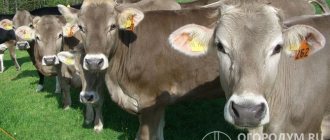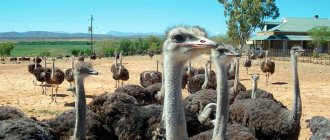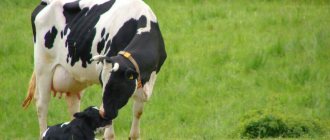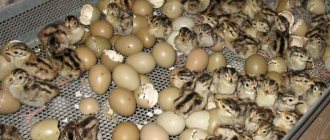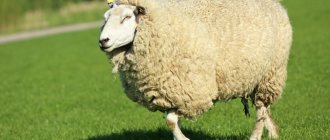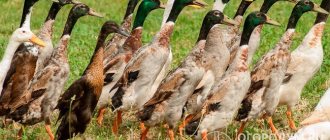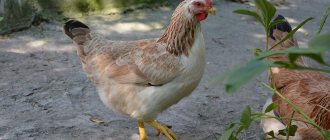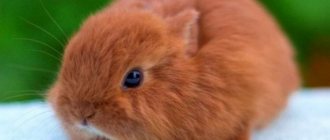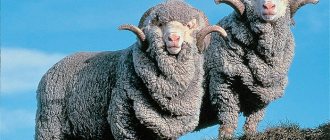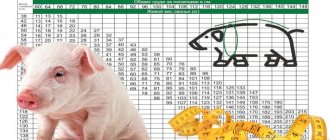Expert opinion
Kosheleva Maria Andreevna
Farmer with 15 years of experience raising goats and cows.
When talking about the body weight of cattle, they use the phrase “slaughter yield of meat.” However, farmers with little experience face difficulties when determining the weight of an animal. In this article we will talk about how many kg of meat are in a cow.
Weight gain and average daily gain of calves
An indicator such as the weight of a bull is the basis of many farming tasks. Using it, you can determine which weight class the bull belongs to, calculate the average daily gain and track the level of development. That is why, in the first months of life, cattle breeders regularly measure the weight of the bull, monitoring the obtained indicators.
The calf actively develops during the first six months of life. During this period, farmers constantly take measurements and monitor weight gain. Strict control is important not only for those calves that are fattened for meat, but also for replacement heifers.
The table below will help you determine the norms of weight and average daily weight gain at the main stages of development of young animals.
The table shows that at 3 months, calves reach an average daily gain of 700 g and maintain it for up to six months. Moreover, during this period of development, the weight of the calf is not at all affected by the class of the calf. The only difference is that a breeding heifer is born with more weight than replacement breeds.
Fattening of dairy and beef bulls for meat
For a more complete description, the relative growth rate indicator was used. Compared to newborns, the live weight of experimental animals increased by 8-10 times by the age of one year, by 13-15 times by the age of 18 months, and by 18-20 times by the age of 30 months. Which also indicates the continued growth of bulls. Interbreed differences are explained by the specialization of breeds and the intensity of metabolic processes in their bodies.
In dairy breed bulls, the average daily gains were slightly lower than in analogues of meat breeds. And yet, these indicators remain high throughout the growing period. As it turns out, the combination of high growth energy and multiple increases in live weight should be used in beef production and raised to an age while this process occurs.
Slaughter
Life expectancy of goats: influence of breed on life expectancy, rules for caring for the animal.
Immediately before slaughter, the animal must be examined by a veterinarian. If during such an inspection any disease is detected, the carcass must be disposed of. In some cases, slaughter has to be postponed. This may be due to recent vaccination or treatment with antibacterial drugs.
Before slaughter, the following manipulations are carried out:
- Cleaning fur and hooves, washing animals.
- Keeping on a starvation diet for 12-18 hours before slaughter, for young animals 6 hours is enough. You should also not use a longer period of fasting; this can immediately reduce productivity by up to 4%. During this period, the animal should be kept in a calm environment and protected from stress: the hormone that is produced during this process significantly worsens the quality of the meat.
- Weighing to determine slaughter weight.
Methods for measuring mass
Jersey cows: how to keep them?
In small farms, scales suitable for weighing cattle are not always at hand. You can find out the weight of cattle without scales, using the Trukhanovsky and Kluwer-Strauch method, as well as by the regression level.
Trukhanovsky method
The Tukhanovsky method is most often used. Its popularity is due to its ease of calculation. During the calculations, the following indicators will be needed: the girth of the animal’s chest and the length of its body. Then these characteristics are multiplied, the resulting number is divided by 100. The result is multiplied by a correction factor or, as it is also called, the percentage of fatness. For dairy cows and bulls it is 2, for meat and meat and dairy cows it is 2.5.
Klüver-Strauch method
To find out the weight of the Swiss breed, you only need the girth of the animal’s chest.
The method is suitable for measuring the mass of both newborn and adult animals
Using Regressions to Determine Mass
To determine the weight of an adult cow by regression level, chest girth is measured. The accuracy of the result depends on the correctness of the measurements. Under the chest, the tape should lie at a distance of 6-8 cm from the elbow. This distance is approximately equal to the width of a person's palm. Depending on the chest girth value, use 1 of 3 formulas:
- If the indicator varies between 1.7-1.8 m, it is multiplied by 5.3. 507 is subtracted from the resulting amount.
- If the indicator varies between 1.81-1.91 m, it is multiplied by 5.3. 486 is subtracted from the resulting amount.
- If the indicator exceeds 1.81-1.91 m, it is multiplied by 5.3. 465 is subtracted from the resulting amount.
During measurements, the animal should not move. It is advisable that it holds its head straight. If it cannot be fixed in one position, measurements are taken several times and an average is displayed.
Burenki also have record holders. A representative of the Holstein-Durchman variety was included in the Red Book. Her height is only 2 cm less than the height of the record-breaking bulls, and is 18 cm. Her weight is 530 kg more and is 2,270 tons. Her chest girth is 4 m. It is difficult to imagine that another cow will ever appear that will surpass These indicators are both in kilograms and meters. To date, not a single cow has come close to this record.
Conversion factors KRS.doc
Cattle conversion factors
- From slaughter weight to live weight:
– highest fatness – 2.06
- average fatness - 2.13
- below average fatness - 2.23
For example: 180 kg. * 2.06= 370.80 kg.
- From live weight to slaughter weight:
How to determine the slaughter yield of cattle meat? This can be done using special tables and data in the percentage of meat yield depending on fatness. You can also use our calculator to determine the slaughter yield of meat; just enter your data and get the result.
Cow weight: how to find out?
Teddy cow: description of the breed, care rules, advantages
The average weight of cattle depends on the following factors:
- breeds and directions (meat, dairy and meat and dairy);
- age;
- gender of the animal (with a female weighing five hundred kilograms, a male of the same breed and age will pull about three hundred and fifty kilograms more);
- conditions of care and maintenance, as well as a balanced diet.
The average weight of a cow that is well cared for and does not suffer from any diseases is approximately three hundred to five hundred kilograms. There are four categories:
- Selected animals whose body weight exceeds 450 kilograms. The maximum value can be no more than 600 kilograms.
- The first category includes animals weighing from 400 to 450 kilograms.
- Second category: 380−400 kg.
- The third category includes individuals with a minimum weight of less than 300 kg and a maximum weight of 380 kg.
Female individuals have these characteristics. As cows age, they lose weight. The average weight of bulls is much higher. It is one and a half to two times higher than that of females.
What does the mass of an animal depend on? Firstly, of course, from the psycho-emotional state. When transported, cows lose approximately twenty percent of their kilograms from fear and excitement. If you weigh a cow that goes out to pasture in the morning and one that grazes in the meadow towards the end of the day, the difference in readings will be significant.
As the animal grows and turns from a small calf into an adult bull or cow, its body weight also changes. Therefore, age greatly influences the parameters of interest to us. Healthy young cows have good muscle mass, therefore, the weight of such cattle is much greater than that of an old individual that has exhausted its resource.
The above figures clearly indicate the health of cattle. If the weight is below normal, this indicates illness or malnutrition and improper care. When buying livestock by live weight, you need to know the method for determining the weight of the animal.
There are two types of cattle: dairy and meat.
Dairy animals are focused on obtaining high milk yields, as well as on its fat content and quality. The weight of dairy breeds is significantly less than that of breeds that are specifically bred for meat.
Meat breeds also produce milk. There are mixed meat and dairy breeds with average performance.
The live weight and the weight of the dressed carcass differ by 40-50 percent. These numbers depend on how well-fed the animal was before slaughter.
The heavyweight record holders are bulls representing the porcelain white breed. Adult males have a body weight reaching 800 kilograms. Among female representatives, the beauties of Mount Katahdin break records. A cow weighing 2270 kilograms is known. Thanks to many years of efforts of breeders, such an outstanding result was achieved.
Average weights
First of all, the BMI of the animal affects meat productivity. The average weight of a female is 350-450 kg, a male – no more than 850 kg.
We invite you to familiarize yourself with the categories of cattle:
- Class A - the best representatives, whose weight starts from 500 kg.
- Class B - average weight reaches 400-500 kg. At the same time, the physique is proportional, without protruding bones and shoulder blades. There is also no visibility of the ischial tuberosities. During castration, a layer of fat is observed on the animal's body.
- Class C – cattle grow up to 450 kg. Satisfactory body parameters with slightly protruding bones. Fat is found in certain places.
- Class D - average values do not exceed 300 kg. Cattle have a poorly developed muscular skeleton, bones are clearly visible, and there is practically no fat. Such individuals are considered defective and are not suitable for slaughter.
How to find out the meat yield
The indicator is measured as a percentage.
It amounts to:
- 40–50% for dairy representatives;
- 80% for meat;
- 70% for meat and dairy.
Important! To calculate the meat yield, the mass is calculated using scales, since all other methods give only approximate figures and are intended to create a complete diet. Slaughter yield increases with age. The amount of meat products is influenced by diet and climatic conditions
It is also important to take into account the purpose of the breed. The average weight of different parts of a meat and dairy cow with a slaughter weight of 700 kg, subject to a meat yield of 60% (420 kg):
The amount of meat products is influenced by diet and climatic conditions
It is also important to take into account the purpose of the breed. The average weight of different parts of a meat and dairy cow with a slaughter weight of 700 kg, subject to a meat yield of 60% (420 kg):
Slaughter yield increases with age. The amount of meat products is influenced by diet and climatic conditions
It is also important to take into account the purpose of the breed. The average weight of different parts of a meat and dairy cow with a slaughter weight of 700 kg, subject to a meat yield of 60% (420 kg):
- head – 10 kg;
- liver – 5 kg;
- tongue – 2 kg;
- heart – 3 kg;
- kidneys – 2 kg;
- front leg to hock joints – 2 kg;
- hind leg – 3 kg;
- skin – 17 kg;
- stomach – 15 kg;
- tail – 2 kg;
- fat – 5 kg;
- bones – 112 kg.
Not every private household has scales. When maintaining, for example, one unit, there is no need to buy them. You can, of course, agree and use those installed on the nearest farm. But if you follow a weighing schedule, you will have to do it too often. Therefore, it is better to use alternative methods for converting linear indicators into weight ones.
According to Trukhanovsky
In this case, use the formula. It is applicable when determining the weight of an adult bull. To calculate, you need to specify two parameters.
- Chest circumference. The measuring location is very close to the bull's front legs. You can measure with a special tape measure or a centimeter.
- Straight body length. That is, find out the distance from the beginning of the neck to the beginning of the tail (see Figure 1). An ordinary stick is suitable for measuring. Make marks on it in the right places, and then measure the distance between them.
Trukhanovsky's formula
- M - measured mass in kg,
- K is the correction factor. Its value is determined by the breed of the animal being measured:
- for meat - K = 2.5,
- for dairy - K = 2,
- A - measured chest circumference (cm),
- B - measured straight length (cm).
To obtain a more accurate value, it is necessary to take into account the fat content of the bull.
- If it is high, add 5 or 10% to the resulting weight.
- If it is low, 5% or 10% is subtracted from the resulting weight.
We suggest you read: How to treat udder swelling in a cow
It is also suitable for determining the weight of an adult bull. Using this method, two measurements are taken in the same way. The first one is the same. But the second one is different. It's called oblique length. How it is measured is shown in Figure 2.
Correct measurements on animals for the Klüver-Strauch method
Table for determining the mass of cattle
Regression equations
With this method, one parameter is used - chest circumference. And then the following formulas are used.
Y1 = 5.3 * X – 507 - applied at X = 170 ÷ 180 (cm).
Y2 = 5.3 * X – 486 - applied at X = 181 ÷ 191 (cm).
Y3 = 5.3 * X – 465 - used for X ≥ 192 (cm);
X - chest circumference (cm).
We examined three universal methods for converting linear measurements of adult cattle into their weight indicators. These methods are suitable for any breed.
- Chest circumference, measured as usual - as close to the front legs as possible.
- Abdominal circumference measured at its widest point.
Measuring the circumference through the widest part of the abdomen. The data obtained is compared with a special table (they can be found on the Internet).
Tape for measuring live weight of cattle of certain breeds
To use it, you must first purchase it, and this is not always easy to do. Then you can take an ordinary centimeter, take the necessary measurements on the animal, and then work with the table. But tape is, of course, more convenient.
With its help, one measurement is taken - chest circumference (closer to the front legs). When taking measurements, there is no need to spare the tape. It is pulled tightly so that the existing hairs are crushed. In this case, the animal should stand calmly, with its head not lowered. As a result, the desired weight of the animal will be immediately written on the tape above the obtained measurement value. Very fast.
Unfortunately, all the proposed methods are not ideally accurate. The error may be 20-30 kg. To get an accurate result, you still need scales.
Livestock weight according to measurements, weight table
In the absence of measuring instruments, pre-made measurements and a special table for determining the weight of cattle allow you to find out the weight of a cow. It gives an idea of the approximate weight of the animal with an error of 20-30 kg. To check, you need to take the following measurements using a tailor's tape or tape measure:
- Body circumference in the sternum area. To measure, the tape is passed behind the animal's shoulder blades and connected in the chest area.
- Oblique length of the body. The tape is pulled from the cow's shoulder to the ischial tuberosity (a special protrusion on it).
Cattle weight measurement
The data obtained during the measurement is entered into a special table. Such tables were developed by experienced livestock breeders and exist in several versions.
Using the regression equation
If you have a measurement of the animal's chest circumference, you can determine the weight on the spot and without using a table. In this case, a special regression equation is used, which has the following form:
In this formula, “Y” means the weight of the cow, “x” is the exact value of the animal’s chest circumference, “X” is a special coefficient that assumes one of three values:
- with a chest circumference of 170–180 cm – 507;
- with an indicator of 181–191 cm – 486;
- if the girth is 192 or more - 465.
Reference. To determine mass, all values are substituted into the formula. The resulting value indicates the approximate weight of the animal and also approximately corresponds to the numbers indicated in the table.
Freuven method
The Freuven method is designed to determine the weight of young animals based on measurements taken. In this case, the chest girth and oblique length of the calf’s body are also measured, but the figures obtained during the measurement are substituted into the table presented below:
Determination of the weight of young animals using the Freuven method
The rules for using the table here are quite simple and actually repeat other table options that are available on the Internet. But the numbers given in the list have been adjusted taking into account the characteristics of the body proportions and growth of the young animals. The weight value is located in the cell located at the intersection of the desired column and row.
Klüver-Strauch method
Another popular measurement method is the Klüver-Strauch method. A table is also used here, but the values presented in it apply only to adult cattle. The Klüver-Strauch list assumes the following form:
Determination of cattle weight by the Klüver-Strauch method
The table is used in the same way as Freuven's version. In accordance with the values of the girth and oblique length of the body of the cow, the corresponding intersection point is selected. It will indicate the mass of living creatures.
Important! This method allows you to monitor the growth rate of the cow and its compliance with recommended standards. In addition, many breeders use it to control the weight of heifers during pregnancy.
Trukhanovsky's technique
You can also obtain the approximate weight of a calf using the Trukhanovsky method. It involves using a mathematical formula:
In it, “Y”, as in the regression equation, means the mass of the animal. The number “A” indicates the circumference of the baby’s chest, “B” is the oblique length of the calf’s body, indicated in centimeters. The letter “K” denotes a special coefficient, which is influenced by the breed of the animal. If the calf belongs to the meat breed, then K = 2.5. In the case when the breed is dairy, K=2.
In addition to all the numbers, for a more accurate result you should also pay attention to fatness. If the calf is overly fat, another 5–10% is added to the result. If the baby is thin, then his weight indicator, on the contrary, is reduced by the specified proportion
If the baby is thin, then his weight, on the contrary, is reduced by the indicated proportion.
Using a special tape
For those breeders who are too lazy to carry out calculations and check with the table, there is an option for measuring the weight of cattle using a special tape. Instead of units of length, units of weight are immediately marked on it. In this case, the measurement is carried out strictly behind the front legs of the cow.
It is worth noting that this method involves the greatest error. Therefore, several rules should be followed when measuring:
- The tape is wrapped as tightly as possible, making sure that it lies strictly perpendicular to the cow’s body and slightly squeezes her sides.
- The measurements are repeated at least three times. The results obtained are summed up and the average value is sought.
- The weight value is compared with the fatness of the cow, after which 5–10% of the result is added or reduced.
Killer exit
To determine it, you need to know the slaughter weight (slaughter weight) of the animal, which is the weight of clean meat after cutting.
It does not include:
- skin;
- internal organs;
- legs (hooves and ankles);
- cattle horns.
In turn, slaughter yield is the ratio of the slaughter weight of livestock to live weight, expressed in shares or percentages.
Influencing factors
A large yield of meat based on live weight is direct evidence of the high quality of pork. Live weight depends on the breed and sex of the animal, and the abundance of food. However, large live weight does not guarantee high slaughter efficiency - the weight can be concentrated in the bones or fat of the internal cavities, unsuitable for food.
Therefore, farmers and breeders are guided by a list of factors influencing meat yield.
Gender of the animal
Females are lighter in scale, their body contains much more fat and less muscle (the female hormone is responsible for this body structure). If you keep a pig for the sake of fat, then it is more profitable to slaughter the sow at the age of two or three years. If the goal is to obtain juicy pork, the ideal option is a piglet or a young boar. With cattle, things are a little different. Calf fat is not that valuable, so only muscle tissue is calculated. Definitely, in this case it is more profitable to slaughter a bull.
Breed
The breed of livestock is of particular importance. There are dairy or meat orientations for cows, meat, meat-fat and tallow varieties for pigs. This will be discussed in more detail at the end of the article.
Body type
It was also noted that the size of the animal itself, in particular its height, directly affects the slaughter efficiency. This rule applies even among animals of the same orientation. With the same nutrition, small pigs and cattle, more compact than their relatives, produce more muscle.
Fatness
Fatness directly affects the amount of the final product. The more meat, the more valuable the carcass.
However, fatness also depends on a number of factors:
- animal health;
- feed nutritional value;
- climatic conditions;
- season of raising livestock (in winter there is a delay in growth, the animal has less weight, and the meat yield also decreases).
Nutrition
Feeding directly affects the animal's growth rate and the muscle-to-fat ratio in its body. The more varied the diet, the healthier and stronger the cattle. A high intake of plant-based protein is important for pigs.
Stress before slaughter
Although stress before slaughter should be avoided, since the released hormone will spoil the taste of the product, short-term shock during introduction to the slaughter area is almost inevitable. It does not have time to affect the quality of the finished product, so it is not taken into account. Moreover, it does not affect the meat yield in any way. However, this only applies to short-term stress. Long-term stress is a real disaster for any organism. Even if the animal does not refuse food, stress has a destructive effect on all cells. There is depletion of livestock, a decrease in the amount of both fat and meat.
Trukhanovsky method
The chest volume of a bull should be measured starting 15 cm from the front legs (A), just behind the protrusions of the shoulder blades. This indicator is determined using a simple centimeter or tape measure, and the second using a regular stick. We take measurements from the neck to the first tail segment. The distance between two points will be the second value for further calculation (B). We multiply the resulting indicators, divide the product by 100 and multiply by the correction factor (K). M=A*B/100*K
For bulls the correction will be 2.5. Live weight (M) is calculated in kilograms. With high fat content, it is increased by 5-10%, and with low fat content, on the contrary, it is reduced.
Standard
The average weight of newborn calves is 30-40 kg, heifers are slightly lighter at birth than bull calves. Over the next 3 days there is active weight gain. Every day the calf gains 800-1000 g. The calf is still too small, its stomach cannot accommodate more than 1.5 liters of food at one feeding. Overfeeding does not have the best effect on young animals: excess milk is thrown into the intestines and often leads to disturbances in the gastrointestinal tract. Because of this feature, small feedings five times a day are recommended.
By the end of the 2nd month of life, the calf already weighs about 80 kg, that is, the weight with which it was born doubles. During the same period, there is a reduction in milk in his diet; he is gradually transferred to the usual feed for cows. This is done so that by 6 months the young animals eat adult food. So at 6 months, calves already weigh 120-180 kg. This is the best time to keep them on pastures, as young animals learn to eat grass. From such food they can get all the substances the body needs in abundance.
By the age of one year, bull calves and heifers weigh up to 400 kg, the daily weight gain becomes somewhat less and amounts to 600-700 g per day. Thus, with normal development, a calf can weigh up to 1000 kg by the age of 3 years. Most often, slaughter occurs at the age of 15-18 months; meat during this period is particularly tender, beneficial for the body and easy to digest.
How much do a bull and a cow weigh?
At birth, on average, a calf's weight is one-tenth that of its mother. Usually we are talking about 40 kilograms. Calves gain weight quickly.
The weight of a one-year-old bull is ten times greater. This characteristic must be constantly monitored, because weight says a lot about your health.
Many livestock breeders raise bulls for no more than one year. During this time, the weight of the bull is approximately 400 to 500 kg. However, if you continue to fatten up to two years, the weight of the animal will reach one ton.
The bull's weight table by month is as follows:
- At birth - 40 kg.
- After 2 months – from 60 to 80 kg.
- A three-month-old bull weighs 100 kg.
- At 6 months – approximately 170 kg.
- By the end of the year he gains 400 kg.
There are certain standards for determining weight. This is the age, sex of the animal and breed.
Depending on the weight, cattle are divided into categories:
- premium grade, weight within 450 – 500 kg;
- first grade, weight up to 450 kg;
- second grade, weight up to 400 kg;
- third grade, weight up to 300 kg;
If the average weight of an animal varies greatly with a permissible deviation of 30 kg for an adult livestock, this means poor care, feeding and the presence of diseases in livestock.
The average weight of a bull is 1.5 times the weight of a cow. With an average cow weight of 750–800 kg, the bull’s weight will be 1200–1500 kg. The average weight of a young cow should not be less than 350 kg.
The weight of a two or three year old cow of the meat breed, if it has good housing conditions, reaches up to 700 kg and more.
The average calf's weight at calving should be about 10% of the cow's weight. This value is 30 – 40 kg depending on the breed and weight of the parents, as well as the sex of the calf. Young animals grow quickly and gain weight if there are no health problems.
It is recommended to weigh animals 2-3 times a month in order to determine in detail for each calf how much a bull or heifer weighs, and to monitor their growth and development.
By the age of one month, weight increases by an average of 10 kg. By six months of life, the weight of the young animals is 60-75 kg and they are transferred to adult care. Weighing should be done once a month. By the age of 1 year, the weight of the bull increases to 250 - 400 kg.
An overview of the reasons when cattle weight control is required:
- Monitoring changes in cattle weight on a daily basis.
- Check and adjust the cattle diet and feeding scheme used.
- In cases where there is a need to carry out certain veterinary measures, the need to weigh them can be important for choosing the correct dosage of drugs or assessing the results of the actions taken.
- Assistance in carrying out breeding work to improve breeds or develop new ones.
- In preparation for sale, correct weight assessment of animals is necessary to estimate expected live weight yield or for other purposes.
The following methods are used to determine the weight of animals:
- Weighing on scales. In this case, the scales are placed along the path of the animals. When the bull steps on the scale, a weigh-in is carried out.
- A live weight measurement table for cattle is used.
- Using certain formulas to calculate the mass of animals.
Weighing of young bulls is usually carried out according to the following rules:
- The first weighing should be done 6 hours after birth. In this case, it is recommended to determine the weight not using a table, but by direct weighing. This is necessary to obtain accurate data.
- Before the two months are up, it is recommended to weigh yourself every ten days. At this age, this procedure is important for monitoring the health and correct development of bulls.
- For a period of two to six months, measurements are recommended to be taken monthly. At this time, weight can be determined using linear measurements and the corresponding table.
- After 6 months, weight monitoring using a tape measure is necessary to compare with the standard indicators that should be in this breed.
- Further weight control is carried out as necessary.
conclusions
In order to prevent a further decrease in the number of cattle, increase the production of high-quality beef and, on this basis, improve the supply of meat to the population, increase the profitability of the industry, it is considered possible to reduce the turnover of livestock and extend the production cycle of raising dairy and beef bulls in the steppe zone to 2.5 years age, live weight 650-700 kg.
During this additional 365-day fattening period, a bull can be inseminated into a cow, in whose womb the fetus will develop in parallel for 285 days. Thus, the agricultural formation will ultimately have two growing heads of livestock during the additional growing period. In the future, this process will continue consistently. The disadvantage of this proposal is a certain time delay in the sale, and therefore in the supply of beef to the market, which can be compensated for once by imports and thereby prevent a reduction in the number of domestic livestock for its subsequent increase.
Author: V. KOZYR, Doctor of Agriculture. Sciences, Professor, Academician of the National Academy of Sciences of Ukraine
Output meat weight
Of course, the live weight of a bull or cow is always much greater than the yield of meat and edible offal. This indicator largely depends on the variety - from dairy breeds, after slaughter you can sometimes get only 40% of the meat, and from meat breeds - up to 80% or even more. On average, it is believed that if a cow weighed less than 500 kg, then the meat yield will be 60–65%, if more, then 70–75%.
You can also determine in advance approximately how much a particular organ weighs in each individual.
Liver is especially prized among offal products. Most often, its weight reaches 1–1.5% of the total weight, that is, on average 6 kg for a female and 9 kg for a male. Another delicious product is tongue. Weight depends on the age and sex of the individual, the maximum weight is 2.5 kg with a length of 35 cm. A popular product is beef heart, its weight ranges from 2–2.5 kg. Stomach – from 15 to 30 kg. The brain is from 350 to 400 g, and the entire head is from 15 to 25 kg. The udder is considered by many to be a rather exotic product, but in a number of areas, dishes made from it are widespread. In dairy cows, this organ weighs up to 30 kg, in meat and dairy cows - about 20 kg, in meat cows - 15 kg.
The front leg is usually divided into two parts. The lower one, that is, the shank or shank, on average tightens by 10–15 kg. Upper (shoulder blade) – 25–40 kg. The shank of the hind leg weighs 15–20 kg, the rump (upper part) weighs 35–50 kg. The weight of the skin of an adult cow is 40–45 kg, that of a bull – 70–80 kg. If it is quite thick, it can be used to make shoes or leather goods.
Differences in weight depending on purpose
Cow breeds are divided according to purpose into:
- meat;
- dairy;
- meat and dairy.
They differ in body composition, weight and performance.
Did you know? The weight of cattle constantly fluctuates. Daily fluctuations vary between 30–40 kg.
Dairy
The smallest representatives of cattle are dairy cows. Their weight data varies within 300 kg for females, 600 for bulls. They are distinguished by a neat physique and small dimensions. Babies are born weighing 20–30 kg.
Dairy heifers reach puberty faster. They can be brought together as early as 2 years of age.
Meat
Large meat animals reach 500 kg at one year of age. Babies are born weighing 40–50 kg. They fatten up quickly on dairy feeding.
Meat cattle breeds include Charolais, Aberdeen Angus, Galloway, Kazakh Whitehead, and Belgian Blue.
Heifers reach sexual maturity at 3 years. Animals are distinguished by high meat productivity. The meat is fatty, juicy, and contains a maximum of animal protein.
Meat and dairy
These are universal animals of a combined direction. Male offspring are used for meat, and high-quality dairy products are obtained from cows. The weight of the female reaches 580–600 kg, the male – 850 and above.
Calves are born weighing 30 kg. Depending on the breed, one of the qualities may be more pronounced. They grow faster and reach sexual maturity earlier than meat representatives.
Interesting information about cows in numbers
When stressed, the hormone cortisol begins to be actively released in the tissues of cows, which causes muscle mass and fat cells to break down.
This is necessary to produce glucose, which helps cope with stress. As a result, the cow’s body begins to actively burn sodium and potassium ions from the muscles to synthesize glucose.
This leads to the fact that the beef becomes tough, and this negatively affects the taste and marketability of the meat. This stress is caused by a lack of water and food, which is typical during long transportation to the slaughterhouse.
A cow weighing 500 kg produces about 10 tons of manure per year, which means that a herd of 100 cows per year will produce a thousand tons of manure. It is worth noting that cow dung is beneficial. For example, if manure was removed from all the cows living in the United States, millions of homes would be supplied with electricity. This amount of manure can produce 100 billion kW per year.
Factors affecting weight
The weight of cattle is related to housing conditions and care, as well as feeding ration. The breed of the animal also plays a significant role. Dairy cows need to be on pasture for a long time, and meat cows are recommended to be kept in a stall or pen.
If they are kept on pasture for a long time and driven over a certain distance, they will lose weight.
Conditions of detention
When constructing or reconstructing another building for a cow barn, a number of requirements must be taken into account:
- Providing livestock with a temperature regime of at least +10°. For young animals not lower than +15°.
- Air humidity in the barn and lighting, air ventilation. If ventilation is provided by window openings, they must be made to open.
- No drafts and a calm environment.
- Animal bedding. This could be straw, sawdust, peat.
- The presence of pasture near the barn will have a positive effect on the milk yield of cows, since fresh air, sunlight, and movement are necessary for animals, especially dairy and meat - dairy breeds.
- If there is a lake or other body of water in the grazing area, it must be fenced off from the herd, as this can cause the livestock to become infected with parasitic diseases. Animals must be given water in a specially organized place with clean water.
- In winter, cattle should be allowed out into the paddock for a walk. Place a stack of hay in the middle and the cows will feed on roughage. Systematic walking of livestock has a positive effect on blood circulation, digestion, and prevents leg disease.
- Manure must be removed daily, as its accumulation and formation of gases cause respiratory complications and lead to hoof pathology.
- When keeping cattle on deep litter, manure is removed once in the spring, and during autumn and winter it is constantly necessary to put it in the stall. With this method, labor costs are reduced, the temperature in the barn increases, but bedding must be prepared twice as much and ventilation must work well.
